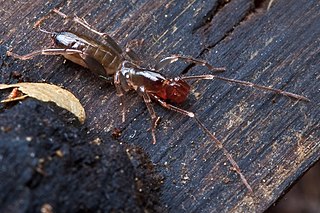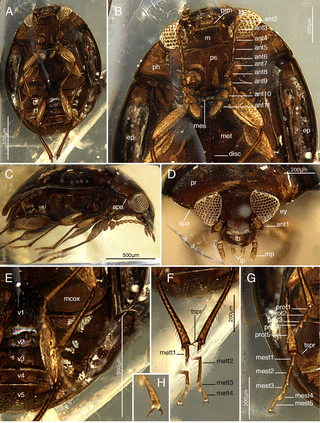
Amblypygi is an order of arachnids also known as whip spiders or tailless whip scorpions, not to be confused with whip scorpions or vinegaroons that belong to the related order Thelyphonida. The name "amblypygid" means "blunt tail", a reference to a lack of the flagellum that is otherwise seen in whip scorpions. Amblypygids possess no silk glands or venom. They rarely bite if threatened, but can grab fingers with their pedipalps, resulting in thorn-like puncture injuries.

Schizomida, also known as sprickets or short-tailed whip-scorpions, is an order of arachnids, generally less than 5 millimetres (0.20 in) in length. The order is not yet widely studied. E. O. Wilson has identified schizomids as among the "groups of organisms that desperately need experts to work on them."

Palpigradi is an order of very small arachnids commonly known as microwhip scorpion or palpigrades.
Michael S. Engel, FLS, FRES is an American paleontologist and entomologist, notable for contributions to insect evolutionary biology and classification. In connection with his studies he has undertaken field expeditions in Central Asia, Asia Minor, the Levant, Arabia, eastern Africa, the high Arctic, and South and North America, and has published more than 925 papers in scientific journals.Some of Engel's research images were included in exhibitions on the aesthetic value of scientific imagery.

Pelecinidae is a family of parasitic wasps in the superfamily Proctotrupoidea. It contains only one living genus, Pelecinus, with three species known from the Americas. The earliest fossil species are known from the Jurassic, and the group was highly diverse during the Cretaceous. Members of Pelecinus are parasitic on larval beetles, flies, green lacewings, and sawflies.

Compsocidae is a family of Psocodea belonging to the suborder Troctomorpha. The family comprises two extant species in two genera, both found in Mesoamerica. Compsocus elegans is found in Mexico and Central America, while Electrentomopsis variegata is found in Mexico. The antennae of each species have 13 or 14 segments. Two extinct genera, Burmacompsocus and Paraelectrentomopsis are known from the Cenomanian aged Burmese amber of Myanmar and Albian aged Spanish amber.

The Ommatidae are a family of beetles in the suborder Archostemata. The Ommatidae are considered the extant beetle family that has most ancestral characteristics. There are only seven extant species, confined to Australia and South America. However, the geographical distribution was much wider during the Mesozoic spanning across Eurasia and Australia, suggesting that they were widespread on Pangea. So far, over 26 extinct genera containing over 170 species of these beetles have been described. Three extant genera have been assigned to this family: Omma,Tetraphalerus and Beutelius. The family is considered to be a subfamily of Cupedidae by some authors, but have been found to be more closely related to Micromalthidae in molecular phylogenies. A close relationship with Micromalthidae is supported by several morphological characters, including those of the mandibles and male genitalia. Due to their rarity, their ecology is obscure, it is likely that their larvae feed on deadwood.

The Brachypsectridae are a family of beetles commonly known as the Texas beetles. There are only two extant genera, Brachypsectra and Asiopsectra. Brachypsectra has a cosmopolitan distribution, mostly in arid regions, while Asiopsectra is found in Central Asia and the Middle East.
This list of fossil arthropods described in 2015 is a list of new taxa of trilobites, fossil insects, crustaceans, arachnids and other fossil arthropods of every kind that have been described during the year 2015. The list only includes taxa at the level of genus or species.
This list of fossil arthropods described in 2016 is a list of new taxa of trilobites, fossil insects, crustaceans, arachnids and other fossil arthropods of every kind that have been described during the year 2016, as well as other significant discoveries and events related to arthropod paleontology that occurred in the year 2016.

Burmese amber, also known as Burmite or Kachin amber, is amber from the Hukawng Valley in northern Myanmar. The amber is dated to around 100 million years ago, during the latest Albian to earliest Cenomanian ages of the mid-Cretaceous period. The amber is of significant palaeontological interest due to the diversity of flora and fauna contained as inclusions, particularly arthropods including insects and arachnids but also birds, lizards, snakes, frogs and fragmentary dinosaur remains. The amber has been known and commercially exploited since the first century AD, and has been known to science since the mid-nineteenth century. Research on the deposit has attracted controversy due to its alleged role in funding internal conflict in Myanmar and hazardous working conditions in the mines where it is collected.

New Jersey Amber, sometimes called Raritan amber, is amber found in the Raritan and Magothy Formations of the Central Atlantic (Eastern) coast of the United States. It is dated to the Late Cretaceous, Turonian age, based on pollen analysis of the host formations. It has been known since the 19th century, with several of the old clay-pit sites now producing many specimens for study. It has yielded a number of organism fossils, including fungi, plants, tardigrades, insects and feathers. The first identified Cretaceous age ant was described from a fossil found in New Jersey in 1966.

Cyclaxyridae are a family of beetles in the superfamily Cucujoidea. The only living genus is Cyclaxyra, with two species endemic to New Zealand. Other species have been named from fossils. They are also known as sooty mould beetles due to the association of Cyclaxyra with sooty mould. The extant species are mycophagous, feeding on spores, conidia, and hyphae.
2017 in paleoentomology is a list of new fossil insect taxa that were described during the year 2017, as well as other significant discoveries and events related to paleoentomology that were scheduled to occur during the year.
Burmese amber is fossil resin dating to the early Late Cretaceous Cenomanian age recovered from deposits in the Hukawng Valley of northern Myanmar. It is known for being one of the most diverse Cretaceous age amber paleobiotas, containing rich arthropod fossils, along with uncommon vertebrate fossils and even rare marine inclusions. A mostly complete list of all taxa described up until 2018 can be found in Ross 2018; its supplement Ross 2019b covers most of 2019.
2015 in paleoentomology is a list of new fossil insect taxa that were described during the year 2016, as well as other significant discoveries and events related to paleoentomology that were scheduled to occur during the year.

Mimarachnidae is an extinct family of planthoppers known from the Cretaceous period. Their name is derived from spots on the wings of the first described genera, Mimarachne and Saltissus, being suggestive of spider mimicry, but these characters are not distinctive for the family as a whole. The family is characterised by "simplified venation and setigerous metatibial pecten and hind leg armature". as well as "rounded anterior margin of pronotum, double carination of pronotum and mesonotum"
Manicapsocidae is a family of Psocodea. It contains 8 extant species in 4 genera, with most of the species being found in the Neotropics and one species in the Afrotropics. The extinct family Electrentomidae has been suggested as a synonym of this family, though this has been considered premature by other scholars in the absence of cladistic analysis. Confirmed fossil species of the family are nearly as numerous as living ones, extending back to the mid-Cretaceous.
Leptokoenenia is a genus of Eukoeneniid microwhip scorpions, first described by Bruno Condé in 1965.
Eukoenenia florenciae is a species of palpigradess, also known as microwhip scorpions, in the Eukoeneniidae family. It was described in 1903 by American arachnologist A. Rucker.










